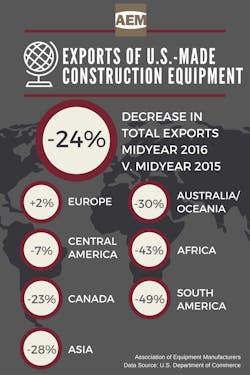A midyear report from the Association of Equipment Manufacturers (AEM) shows that global sales of U.S.-made construction equipment continue to drop, despite overall growth in the global construction market. Business Monitor International predicts that the global construction industry will grow 3.4% in 2016, but roughly half of that growth is expected to be from sales within the North American market.
The AEM report shows that first quarter 2016 exports of U.S. equipment were down 24% compared to first quarter sales in 2015. With a total $2.7-billion of U.S.-made equipment shipped to global markets, the 2016 midyear sales mark the 13th quarter in which year-over-year U.S. exports continue to decrease.
The report cites data from the Department of Commerce to measure U.S. exports by dollar volume for seven world regions (fig. 1.) Europe was the only region to increase purchases of construction equipment from the U.S. (by 5%). Meanwhile exports to Central America were relatively steady, only decreasing by 1%. The sharpest declines in exports were to Africa and South America, which are both down nearly 50%.
The AEM’s director of market intelligence, Benjamin Duyck says the decreases in global sales are due to the increasing value of the U.S. dollar, which makes U.S. equipment more expensive compared to equipment made in other countries.
Earthmoving equipment saw the largest decrease in exports, measuring roughly 35%. A small increase was seen by the lifting equipment segment, which is driven by self-propelled aerial work platforms.
The AEM report also shows the countries that bought the most U.S.-made construction machinery during Q1 2016. These were:
- Canada - $1.1 billion, down 28%
- Mexico - $310 million, down 0.01%
- Australia - $148 million, down 10%
- Belgium - $101 million, up 38%
- Peru - $85 million, down 17%
- Germany - $74 million, up 58%
- Chile - $60 million, down 48%
- China - $49 million, down 31%
- United Kingdom - $47 million, up 8%
- South Africa - $40 million, down 65%
In addition to increasing its purchase of U.S. construction equipment by 38%, Belgium ranked as the fourth highest importer of U.S. equipment, perhaps because its Port of Antwerp serves as a pass-through for the European continent. Growth in Germany is accredited to a boost in excavators and wheel loader exports, while increased exports to the UK appear to be driven by an increase in self-propelled aerial work platforms.
AEM also released reports for U.S. agriculture equipment. Both global-market reports are available for download by members.


